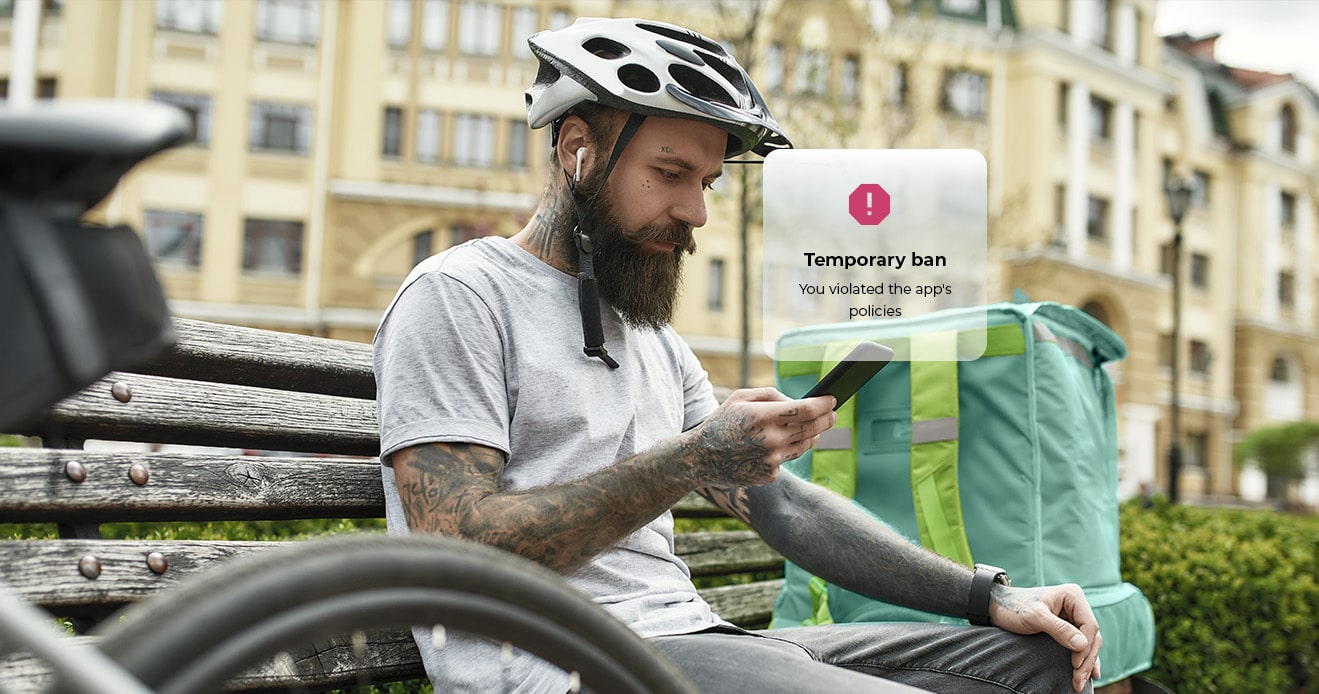- Blog
- Taking a closer look at driver fraud response strategy on food delivery apps
Taking a closer look at driver fraud response strategy on food delivery apps
Subscribe to the Incognia Newsletter
Here’s an unfortunate truth: fraud happens.
Fraudsters are opportunistic offenders, and wherever they see an opportunity to exploit a loophole, policy, or technology, they’ll seize it. Food delivery apps are just as viable a target for bad actors as other apps, and that means that food delivery stakeholders have to craft a response strategy: how do we deal with fraud? What do we do to prevent it, and when we can’t prevent it, what do we do with users we catch violating policies or committing fraud?
Just like fraud types and challenges vary from platform to platform, so too will each platform’s response and penalty system for catching fraudsters in the act. Factors like age of the platform, size of the user base, type of fraud, and availability of new users to replace penalized ones will all have an impact on how a fraud team decides to deal with bad actors. But how big of an impact do these factors have? And how much of a response strategy should be proactive, instead of reactive?
Types of fraud responses food delivery apps use today
We might imagine fraud response strategies as a sliding scale from more to less severe, with multiple outside factors dictating the outcome to each individual case, from available talent pool, the account’s past history with bad actions, the severity of the fraud, the scale of the platform’s overall fraud problem, and so on.
As Felipe Cerquiera of Rappi points out in our recent webinar about stopping fraud on courier platforms, every response strategy feature has to be carefully considered before implementing, because every new feature is going to have an impact on driver numbers and fraud numbers. Permanent bans on every driver caught GPS spoofing will certainly reduce GPS spoofing numbers, but it may also increase the number of ban evasions or decrease the number of drivers actively working with the platform.
Because of the number of factors and consequences at play, permanent bans aren’t treated the same way universally—some platforms and local markets will be much more comfortable wielding bans than others. Temporary suspensions are another form of penalty food delivery platforms might choose to exercise. Account restrictions—i.e., restricting high-risk accounts to only certain delivery areas or locking certain account privileges—are yet another way to continue allowing drivers to work without letting them get off scot-free for violating policies.
Felipe also mentions another crucial element of response strategy: communication. Many fraudsters are career offenders who treat defrauding various platforms as a full-time gig, but many more are opportunistic offenders who are otherwise normal users of the app. Communicating policies (and consequences for breaking them) clearly to couriers can be an effective way to dissuade some fraudsters from going through with abusive behaviors.
How available talent affects response strategy
In a perfect world, the most effective method for reducing fraud numbers would be the one put in place, every time. In reality, different local markets, different apps, and different user bases all call for different approaches. Any new fraud prevention measure put into place is going to increase friction for the existing user base, and so fraud prevention teams have to carefully consider whether any potential churn is worth the benefits—or even if any churn is allowable at all.
As Shawn Colpitts of JustEat Takeaway points out, there are some markets that won’t consider permanent bans except as a last resort, because they need to ensure their driver pool is high enough to service their customer base. In this type of ecosystem, balancing churn and driver loss with fraud prevention efforts is much more delicate than in a saturated labor market.
Emphasizing detection over response
We’ve talked about what the most optimal response strategies might look like, but truthfully, the most optimal response strategy might be one where responses are limited—that is, one where fraud happens less in the first place because of solid detection and prevention solutions.
Fraudsters are smart, and many of them make a career out of outfoxing technologies meant to find them. Some level of fraud is inevitable, which is why having a response strategy is important, but ideally, the less you have to use it, the better.
Users who join a platform looking to commit fraud often bring signs along with them of their intentions; for example, a device integrity check at onboarding might reveal a rooted or jailbroken device, app tampering tools, App Cloner or similar programs, emulators, GPS spoofing apps, and more. All of these increase the likelihood of that user committing policy abuses and fraud on the app later down the line, but knowing about that risk ahead of time could help fraud prevention teams in their decisioning.
Even if preventing a new signup isn’t an option due to limited labor resources, high-risk users can still have restricted access to different jobs, areas, or account privileges that can help mitigate the risk of policy abuse.
Location intelligence is another powerful early risk indicator for preventing fraud on food delivery apps. When banning accounts actually is a valid response strategy, committed fraudsters often ban evade by creating new accounts on factory reset or newly-purchased devices. Tamper-resistant location tech can be used as a second layer of security to identify these users even when they try to change up their parameters for an easy way back onto the platform.
Like the problem of fraud itself, there’s no magic answer to fraud response strategy, because the best strategy changes all the time. That said, staying vigilant and trying to stop fraud before it starts with early user journey risk signals can help strengthen an already strong strategy and minimize fraud numbers.




